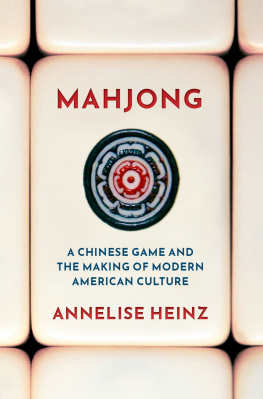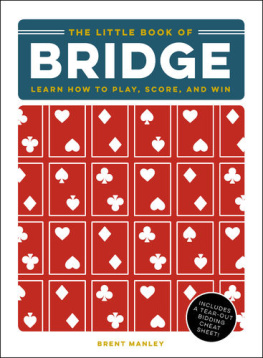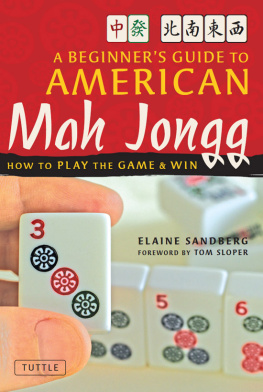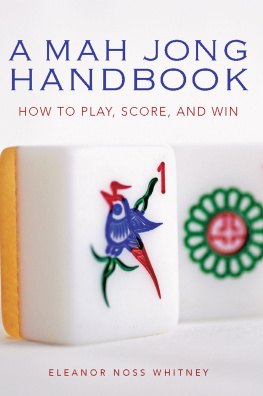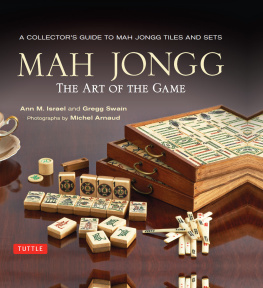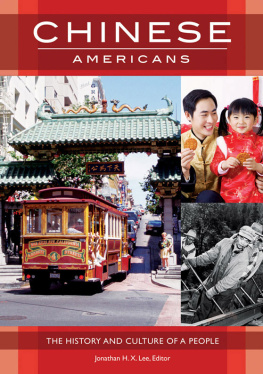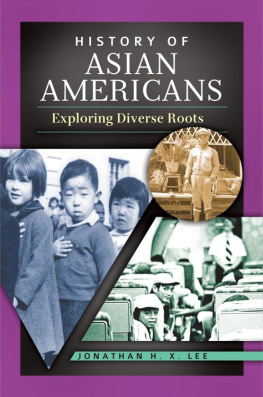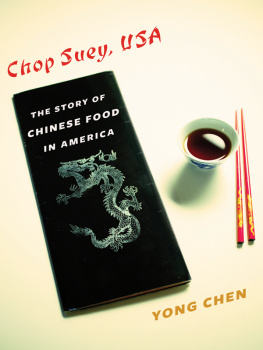Mahjong

Oxford University Press is a department of the University of Oxford. It furthers the Universitys objective of excellence in research, scholarship, and education by publishing worldwide. Oxford is a registered trade mark of Oxford University Press in the UK and certain other countries.
Published in the United States of America by Oxford University Press
198 Madison Avenue, New York, NY 10016, United States of America.
Oxford University Press 2021
Portions of chapter 4 appear in Annelise Heinz, Performing Mahjong in the 1920s: White Women, Chinese Americans, and the Fear of Cultural Seduction, Frontiers:A Journal of Women Studies 37, no. 1 (2016): 3265. The Frontiers Editorial Collective. Portions of chapters 9 and 10 appear in Annelise Heinz, Maids Day Off: Leisured Domesticity in the Mid-Twentieth-Century United States, American Historical Review 125, no. 4 (October 2019): 13161331. Published by Oxford University Press.
All rights reserved. No part of this publication may be reproduced, stored in a retrieval system, or transmitted, in any form or by any means, without the prior permission in writing of Oxford University Press, or as expressly permitted by law, by license, or under terms agreed with the appropriate reproduction rights organization. Inquiries concerning reproduction outside the scope of the above should be sent to the Rights Department, Oxford University Press, at the address above.
You must not circulate this work in any other form and you must impose this same condition on any acquirer.
Library of Congress Cataloging-in-Publication Data
Names: Heinz, Annelise, author.
Title: Mahjong : a Chinese game and the making of
modern American culture / Annelise Heinz.
Other titles: Mah jong
Description: New York : Oxford University Press, [2021] |
Includes bibliographical references and index.
Identifiers: LCCN 2020041162 (print) | LCCN 2020041163 (ebook) |
ISBN 9780190081799 (hardback) | ISBN 9780190081812 (epub) |
ISBN 9780190081829
Subjects: LCSH: Mah jongSocial aspectsUnited States. |
United StatesCivilizationChinese influences.
Classification: LCC GV1299.M3 H45 2021 (print) | LCC GV1299.M3 (ebook) |
DDC 795.34dc23
LC record available at https://lccn.loc.gov/2020041162
LC ebook record available at https://lccn.loc.gov/2020041163
DOI: 10.1093/oso/9780190081799.001.0001
for Katie and for Jane
Contents
mahjong is played with tiles instead of cards, but like a deck of cards these tiles have suits. Now and in the past, Chinese tiles are chunky: over an inch long, about an inch wide, and at least half an inch deep, they are thick enough to stand on their ends. American tiles are thinner and stand upright with the help of a rack. Players line their hands, or set of selected tiles, up in front of them much as card players fan their hand of cards to see their options away from the prying eyes of others.
Like playing cards, the backs of the tiles are identical to ensure that players cannot identify which tiles others have. On the face of the tiles are markings that differentiate three suits: Circles, Bamboo, and Characters. (The character tiles include Chinese numbers and, most often, the character for ten thousand, or wan.) These designs originate from stylized depictions of money. For example, Chinese coins with holes in the middle were the circles, and long strings of these coins evolved into sticks of bamboo. In American parlance, these are known most commonly as Dots, Bams, and Craks. There are four sets of tiles 1 to 9 in each suit, totaling 36 in each. As in much of mahjong, there are intricacies in the designs: the 1 bam tile, for example, depicts a bird rather than a single rod of bamboo.
In addition, there are two groups of nonsuited tiles: honor tiles and flowers. Honors include the four cardinal directions (Winds) and three colors (white, green, and red) known in the West as dragons. Since there are four of each of these sets, there are a total of 28 honor tiles. Flowers can have a variety of scenic images. Their name draws from one of the most common designs, with flowers that represent the seasons in traditional Chinese art. In more elaborate carvings, the tiles can be lined up in a row and recreate a scene from an iconic Chinese opera or paint a picturesque landscape. Most commonly, these markings are engraved or recessed into the face of the tiles, so experienced Chinese players take pride in knowing which tiles they draw simply by feeling the grooves with their thumbs.
Flowers have been the most controversial tiles and have varied in number at times. The standard form, however, is with eight flower tiles that all look different from each other. After 1960, the National Mah Jongg League changed the tiles by adding a specific set of Joker tiles as well, to differentiate from the previous practice of using flowers as wild cards. Taiwanese mahjong sets have introduced a 100 uses tile similar to American jokers, while other regional styles play with different numbers of tiles. With the exception of Japanese and Vietnamese sets, most styles of play without jokers use sets with 144 tiles. With jokers, the tiles in American sets total 152.
All over the world, there are different ways of playing mahjong, some of which have branched quite far from the original form. However, there are some core historic commonalities. Though there are many variations, these are the standard elements of play.
To begin, four players begin by mixing, or washing, the tiles face down in the center of a square table. The clatter of the tiles against each other and the table can be quite noisy, and mahjong players often cover the tabletop with a cloth or felt to soften the racket. The players then work together to quickly build a (rough) square from the tiles. Each side of the wall is a double-decker stack of two facedown tiles. The combined steps of mixing and building the wall work together as a highly effective shuffling strategy.
The roll of dice determines where in the wall to begin drawing tiles. Each player takes four tiles in turn, as the players complete the initial draw. Experienced players zip along as the central square wall quickly fragments into each players hand of 13 tiles. In the American style, players then exchange tiles in an additional shuffling process known as the Charleston. Expert American players say that the game is won or lost in the Charleston, when players determine which hands they are best set up to win. In both Chinese and American standard forms, the goal is to complete a hand with a final additional tile, resulting in a winning combination of 14 tiles.
Well learn more about how American mahjong came to be distinct from Chinese play, but, in brief, the Chinese version is fairly similar to the card game gin rummy: most winning hands involve four sets of three tiles and a pair, and until the birth of the National Mah Jongg League in the late 1930s, most Americans played that way, too. After the League came into existence, they established a more limited number of acceptable hands with more variations in combinations, which change on an annual basis. For both, rules govern how tiles can be drawn from the wall or snatched from the discard
Mahjong is primarily a game of skill. Luck is always present; debates over the use of flowers or jokers have centered on whether to introduce more luck, and if that reduces the games challenge. Learning the basics of the traditional game does not take longlike gin rummy, it can be learned in the span of an afternoon. Mastering the scoring and strategy, however, can take a lifetime. The American game has a slightly steeper initial learning curve, in part because the strategy revolves around a smaller number of acceptable hands. Adherents of the different styles tend to be fiercely loyal to their own and will defend the merits of its intellectual demands or, depending on their experience, the friendly socializing it fosters. The game of bridge is a frequent point of comparison, and many American mahjong players play bridge as well. Unlike bridge, which demands constant concentration to simply play the game (in part because it is a partnered game and one players performance affects a partner), mahjong involves individual players and can be played along a spectrum of competitiveness. All forms of mahjong can be played in highly competitive, fast-paced, and demanding games. Alternatively, most forms can also be played more socially, and regular groups form according to preference. In almost any scenario, however, chatting

